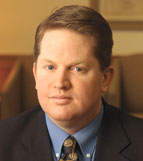‘Court’-ing Diversity
 Enrolling
a diverse student body at Rochester will remain a priority, says the director
of undergraduate admissions for the College as he and colleagues around the
country await a much-anticipated Supreme Court ruling. By Greg MacDonald
Enrolling
a diverse student body at Rochester will remain a priority, says the director
of undergraduate admissions for the College as he and colleagues around the
country await a much-anticipated Supreme Court ruling. By Greg MacDonald
I cannot imagine a single college admissions director anywhere around the country who won’t be carefully watching the Supreme Court case this term involving affirmative action policies at the University of Michigan. (The University has joined 37 other private universities in an amicus brief supporting Michigan.)
The court’s decision—expected in June—will set the tone for what happens in admissions decisions at every selective institution in the nation.
“We stand at the threshold of a decision that will have a profound impact on our nation’s higher education system, and on our race relations broadly,” says Mary Sue Coleman, president of the University of Michigan.
Since 1978, the governing principle in affirmative action in college admissions has come from Regents of the University of California v. Bakke, the last definitive case argued before the Supreme Court.
In the 5–4 ruling, Justice Lewis F. Powell Jr.’s opinion became the guiding light for higher education, when he wrote that colleges and universities could not use quotas in admissions but could give some consideration to race in their efforts to increase the diversity of their student bodies.
The two cases against Michigan—
one against the law school, and the other against the undergraduate program
at the Ann Arbor campus—test this widely adopted principle of affirmative action.
While a selective institution such as ours looks foremost at each applicant’s ability to succeed in the challenging environment of a national research university, the overall diversity of each year’s entering class is also an important consideration.
A “diverse class” means a broad range of individuals in terms of personal and intellectual outlook, geographic origins, race, ethnicity, nationality, academic interest, extracurricular activities, and similar dimensions.
There is a compelling reason to enroll a diverse student body: It helps us to offer the best possible campus setting for a first-class educational experience.
College is the time for students to immerse themselves in scholarship, in thought, and in debate—and to prepare for a global society. How can they most productively do so if their peers conform to a narrow subset of society?
And in the process of working to enroll a diverse student body, we open up our doors to qualified individuals who some decades ago may not have had the opportunity or encouragement to attend such an institution, despite the fact (as we now know) that they would have succeeded, sometimes with great distinction.
Our University offers a comprehensive set of degree programs at the bachelor’s, master’s, and doctoral levels and across a full range of disciplines including the arts, sciences, engineering, music, medicine, nursing, and business.
While I can speak most knowledgeably about the undergraduate admissions office for the College. I know that the belief in the value of diversity extends across all of the University’s programs.
There is great uncertainty as to how the decision will come out. We, and other selective institutions, can only wait and see what happens and be prepared to take the appropriate steps to conform to the court’s interpretation of the Constitution and other applicable law.
Whatever the decision, however, it will not change our own view about the fundamental importance of diversity to the educational mission of
a university. Our commitment to a
diverse student body is part and parcel of our commitment to the high quality of intellectual discussion on campus, and it produces a campus that is more like the world in which our students will live and work once they graduate.
This is a reality of higher education that we can’t dismiss, no matter what decision the Supreme Court hands down in the coming year.
Greg MacDonald is director of undergraduate admissions for the College. Used with permission of the Rochester Democrat and Chronicle, where this essay originally appeared.
![[NEWS AND FACTS BANNER]](/URClipArt/news/titleNewsFactswide.jpg)

![[NEWS AND FACTS BANNER]](/URClipArt/news/titleNewsFactswide.jpg)
